Application of Four Different Models for Predicting the High-Temperature Flow Behavior of 1420 Al–Li Alloy
Abstract
1. Introduction
2. Experiments and Methods
3. Results
3.1. True Stress–Strain Curve of the Material
3.2. Arrhenius (AR) Model
3.3. Modified Johnson–Cook (MJC) Model
3.4. Modified Zerilli–Armstrong (MZA) Model
3.5. VOCE Model
4. Discussion
4.1. Comparison of Ontogenetic Model Predictions
4.2. Effect of Deformation Parameters on the Accuracy of the Intrinsic Model
4.3. Conditions of Application of Different Intrinsic Structure Models
5. Conclusions
Author Contributions
Funding
Data Availability Statement
Acknowledgments
Conflicts of Interest
References
- Luo, R.; Cao, Y.; Cui, S.G.; Peng, C.-T.; Yang, Y.; Liu, T.; Chen, L.; Zhou, Y.; Qiu, Y.; Xu, Y.; et al. An Improved Constitutive Model Based on BP Artificial Neural Network and 3D Processing Maps of a Spray-Formed Al-Cu-Li Alloy. Trans. Indian Inst. Met. 2021, 74, 1809–1817. [Google Scholar] [CrossRef]
- Zhu, Y.; Cao, Y.; Liu, C.; Luo, R.; Li, N.; Shu, G.; Huang, G.; Liu, Q. Dynamic behavior and modified artificial neural network model for predicting flow stress during hot deformation of Alloy 925. Mater. Today Commun. 2020, 25, 101329. [Google Scholar] [CrossRef]
- Zhang, Z.; Huang, Y.; Qin, R.; Ren, W.; Wen, G. XGBoost-based on-line prediction of seam tensile strength for Al-Li alloy in laser welding: Experiment study and modelling. J. Manuf. Process. 2021, 64, 30–44. [Google Scholar] [CrossRef]
- Onoro, J. High-temperature mechanical properties of aluminium alloys reinforced with titanium diboride (TiB2) particles. Rare Met. 2011, 30, 200–205. [Google Scholar] [CrossRef]
- Xue, B.W. Adiabatic shear localization for steels based on Johnson-Cook model and second- and fourth-order gradient plasticity models. J. Iron Steel Res. Int. 2007, 14, 56–61. [Google Scholar] [CrossRef]
- Zhu, H.; Ou, H.A. Constitutive modelling of hot deformation behaviour of metallic materials. Mat. Sci. Eng. A 2022, 832, 142473. [Google Scholar] [CrossRef]
- Ashtiani, H.R.R.; Shayanpoor, A.A. New constitutive equation utilizing grain size for modeling of hot deformation behavior of AA1070 aluminum. Trans. Nonferrous Met. Soc. China 2021, 31, 345–357. [Google Scholar] [CrossRef]
- Shi, C.J.; Mao, W.M.; Chen, X.G. Evolution of activation energy during hot deformation of AA7150 aluminum alloy. Mat. Sci. Eng. A 2013, 571, 83–91. [Google Scholar] [CrossRef]
- Liu, Y.; Li, M.; Ren, X.W.; Xiao, Z.-B.; Zhang, X.-Y.; Huang, Y.-C. Flow stress prediction of Hastelloy C-276 alloy using modified Zerilli−Armstrong, Johnson−Cook and Arrhenius-type constitutive models. Trans. Nonferrous Met. Soc. China 2021, 30, 3031–3042. [Google Scholar] [CrossRef]
- Zhao, Q.; Chen, W.; Lin, J.; Huang, S.; Xia, X. Hot deformation behavior of 7A04 aluminum alloy at elevated temperature: Constitutive modeling and verification. Int. J. Mater. Form. 2020, 13, 293–302. [Google Scholar] [CrossRef]
- Yu, R.; Li, X.; Li, W.; Chen, J.; Guo, X.; Li, J. Application of four different models for predicting the high-temperature flow behavior of TG6 titanium alloy. Mater. Today Commun. 2021, 26, 102004. [Google Scholar] [CrossRef]
- Dong, F.; Yu, P.; Zhang, C.; Zhao, J. Modified Johnson-Cook constitutive model and damage model for 1420 Al-Li alloy. Metall. Funct. Mater. 2021, 28, 28–36. [Google Scholar] [CrossRef]
- Zhang, J.; Yi, Y.; Huang, S.; Mao, X.; He, H.; Tang, J.; Guo, W.; Dong, F. Dynamic recrystallization mechanisms of 2195 aluminum alloy during medium/high temperature compression deformation. Mat. Sci. Eng. A 2021, 804, 140650. [Google Scholar] [CrossRef]
- Mohammadi, H.; Eivani, A.R.; Seyedein, S.H.; Ghosh, M.; Jafarian, H. An investigation of hot deformation behavior of Zn–22Al alloy and development of its processing maps during isothermal compression. J. Mater. Res. Technol. 2021, 14, 507–520. [Google Scholar] [CrossRef]
- Puchi-Cabrera, E.S.; Guérin, J.D.; La Barbera-Sosa, J.G.; Dubar, M.; Dubar, L. Plausible extension of Anand’s model to metals exhibiting dynamic recrystallization and its experimental validation. Int. J. Plast. 2018, 108, 70–87. [Google Scholar] [CrossRef]
- Wu, H.; Xu, W.; Wang, S.; Yang, Z.; Chen, Y.; Teng, B.; Shan, D.; Guo, B. A cellular automaton coupled FEA model for hot deformation behavior of AZ61 magnesium alloys. J. Alloys Compd. 2020, 816, 152562. [Google Scholar] [CrossRef]
- Gao, Y.; Xue, X.; Gao, H.; Luo, W.; Wang, K.; Li, S.; Liu, X.; Du, Y. Investigation of High-Temperature Constitutive Behavior of Ti555211 Titanium Alloy Subjected to Plastic Deformation in the Different Phase Regions. Metals 2022, 12, 1562. [Google Scholar] [CrossRef]
- Abbasi-Bani, A.; Zarei-Hanzaki, A.; Pishbin, M.H.; Haghdadi, N. A comparative study on the capability of Johnson–Cook and Arrhenius-type constitutive equations to describe the flow behavior of Mg–6Al–1Zn alloy. Mech. Mater. 2014, 71, 52–61. [Google Scholar] [CrossRef]
- Lin, Y.C.; Chen, X.M.; Liu, G. A modified Johnson–Cook model for tensile behaviors of typical high-strength alloy steel. Mat. Sci. Eng. A 2010, 527, 6980–6986. [Google Scholar] [CrossRef]
- Ye, J.H.; Chen, M.H.; Wang, N.; Xie, L. Rheological behavior of TA12 titanium alloy at high temperature based on modified JC model. Chin. J. Nonferrous Met. 2019, 29, 733–741. [Google Scholar] [CrossRef]
- Samantaray, D.; Mandal, S.; Borah, U.; Bhaduri, A.; Sivaprasad, P. A thermo-viscoplastic constitutive model to predict elevated-temperature flow behaviour in a titanium-modified austenitic stainless steel. Mat. Sci. Eng. A 2009, 526, 1–6. [Google Scholar] [CrossRef]
- Gurusamy, M.M.; Rao, B.C. On the performance of modified Zerilli-Armstrong constitutive model in simulating the metal-cutting process. J. Manuf. Process. 2017, 28, 253–265. [Google Scholar] [CrossRef]
- Zhan, H.; Wang, G.; Kent, D.; Dargusch, M. Constitutive modelling of the flow behaviour of a β titanium alloy at high strain rates and elevated temperatures using the Johnson-Cook and modified Zerilli-Armstrong models. Mat. Sci. Eng. A 2014, 612, 71–79. [Google Scholar] [CrossRef]
- Samantaray, D.; Mandal, S.; Bhaduri, A.K. A comparative study on Johnson Cook, modified Zerilli-Armstrong and Arrhenius-type constitutive models to predict elevated temperature flow behaviour in modified 9Cr-1Mo steel. Comp. Mater. Sci. 2009, 47, 568–576. [Google Scholar] [CrossRef]
- An, H.; Xie, G.; Zhang, H.; Wang, X. A modified Zerilli–Armstrong constitutive model to predict hot deformation behavior of 20CrMo alloy steel. Mater. Des. 2014, 56, 122–127. [Google Scholar] [CrossRef]
- Liu, L.; Yao, Y.; Zeng, T. A micromechanical analysis to the elasto-viscoplastic behavior of solder alloys. Int. J. Solids Struct. 2019, 159, 211–220. [Google Scholar] [CrossRef]
- Sainath, G.; Choudhary, B.K.; Christopher, J.; Samuel, E.I.; Mathew, M. Applicability of Voce equation for tensile flow and work hardening behaviour of P92 ferritic steel. Int. J. Press. Vessel. Pip. 2015, 132, 1–9. [Google Scholar] [CrossRef]
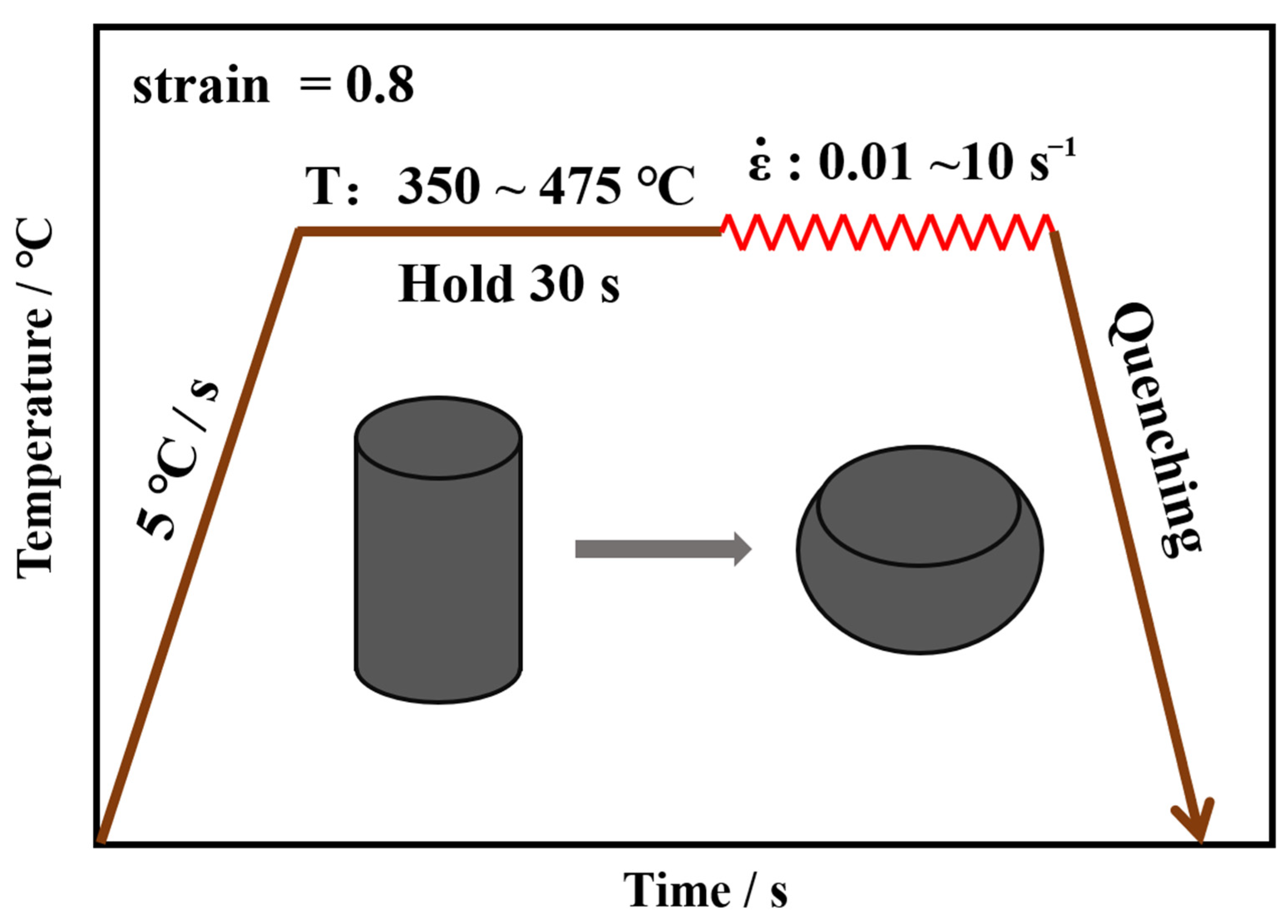
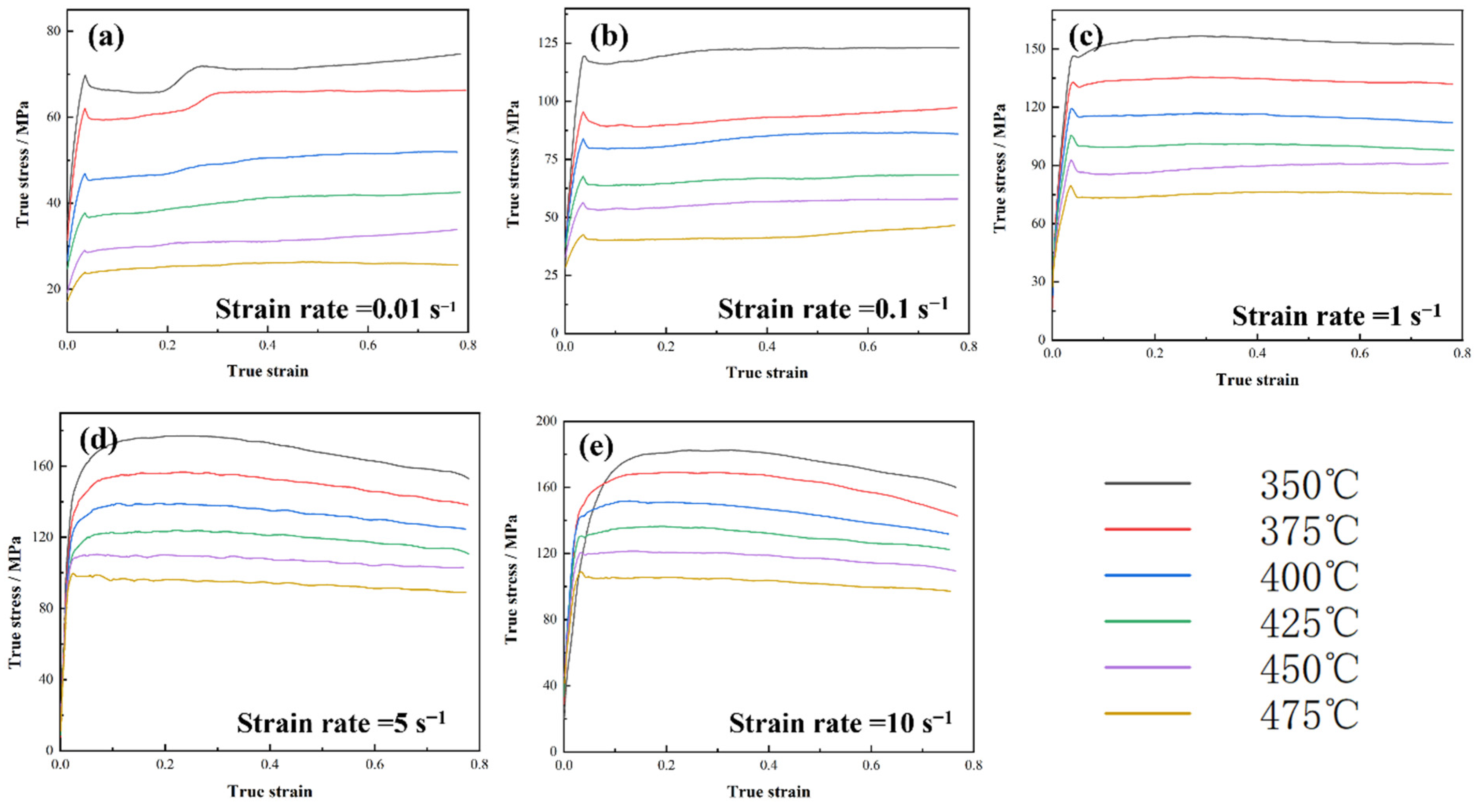
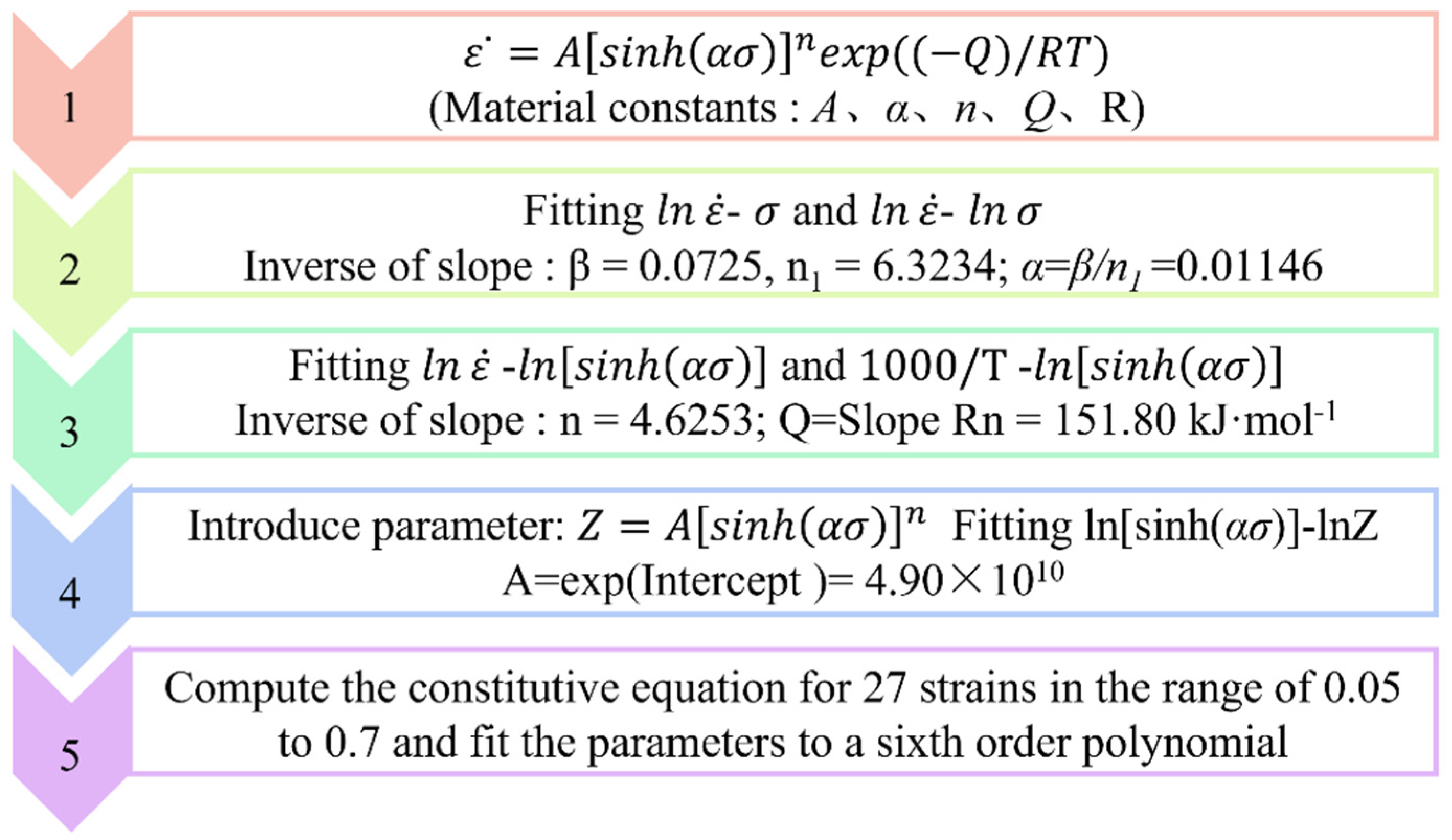
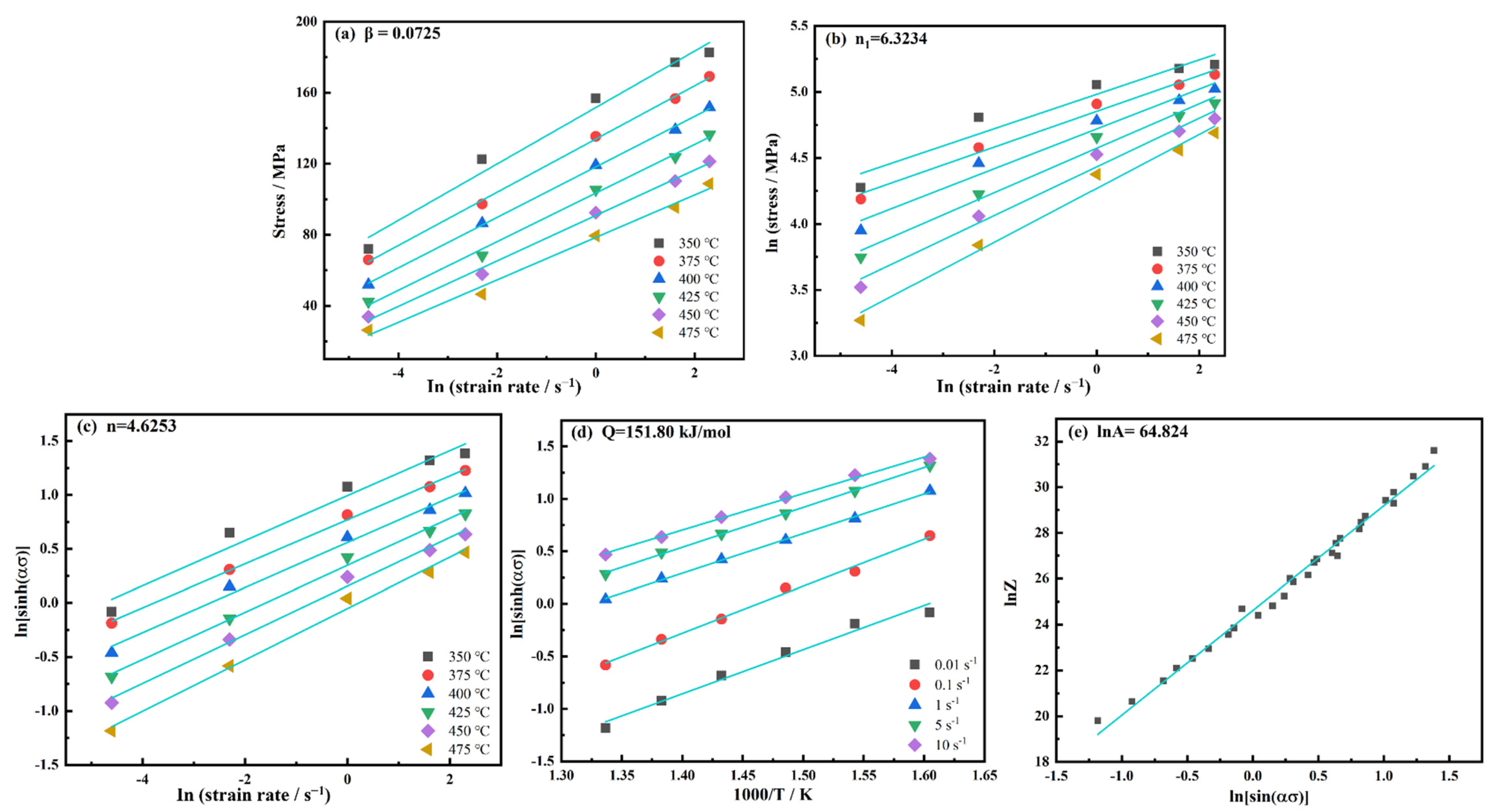
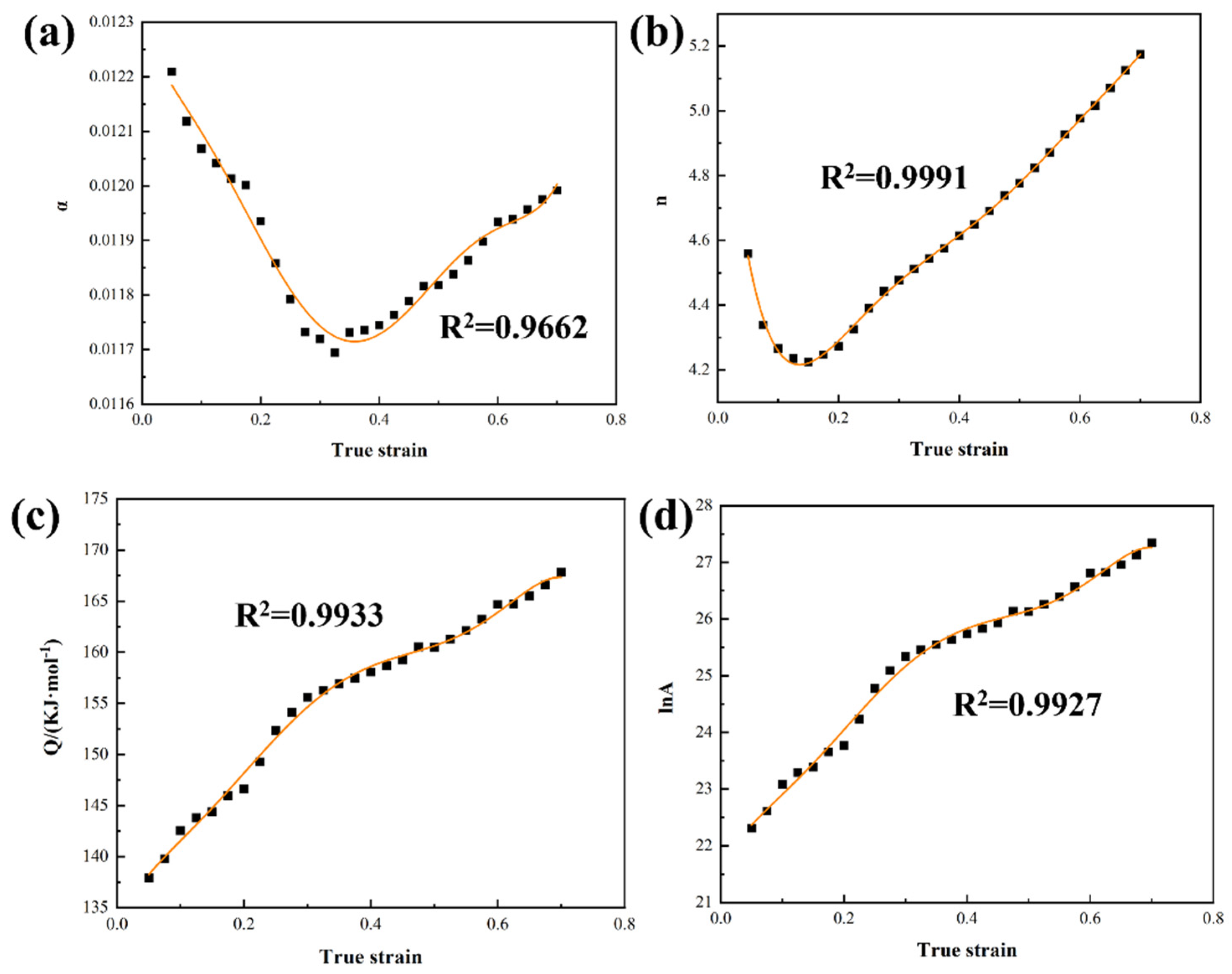

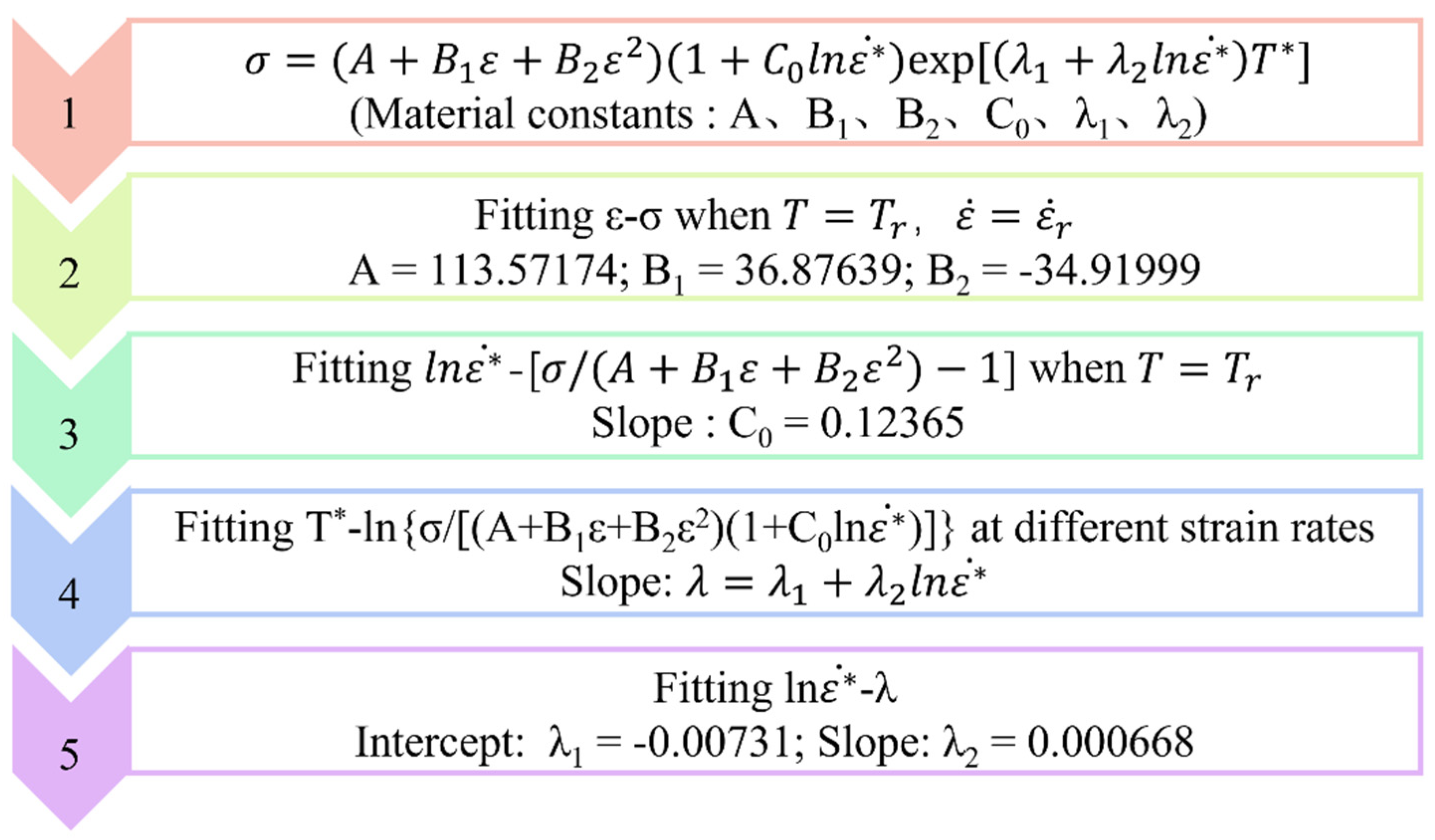
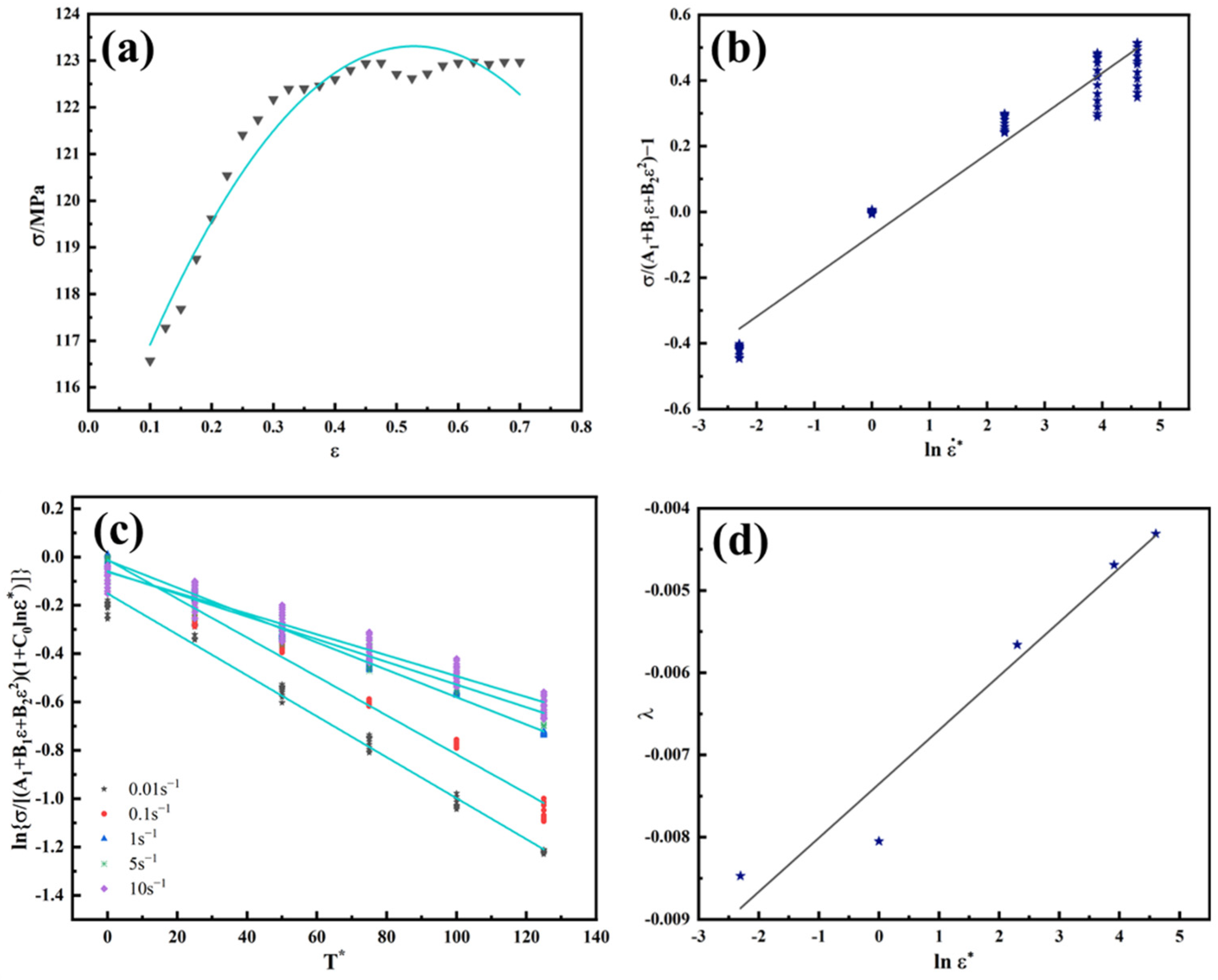
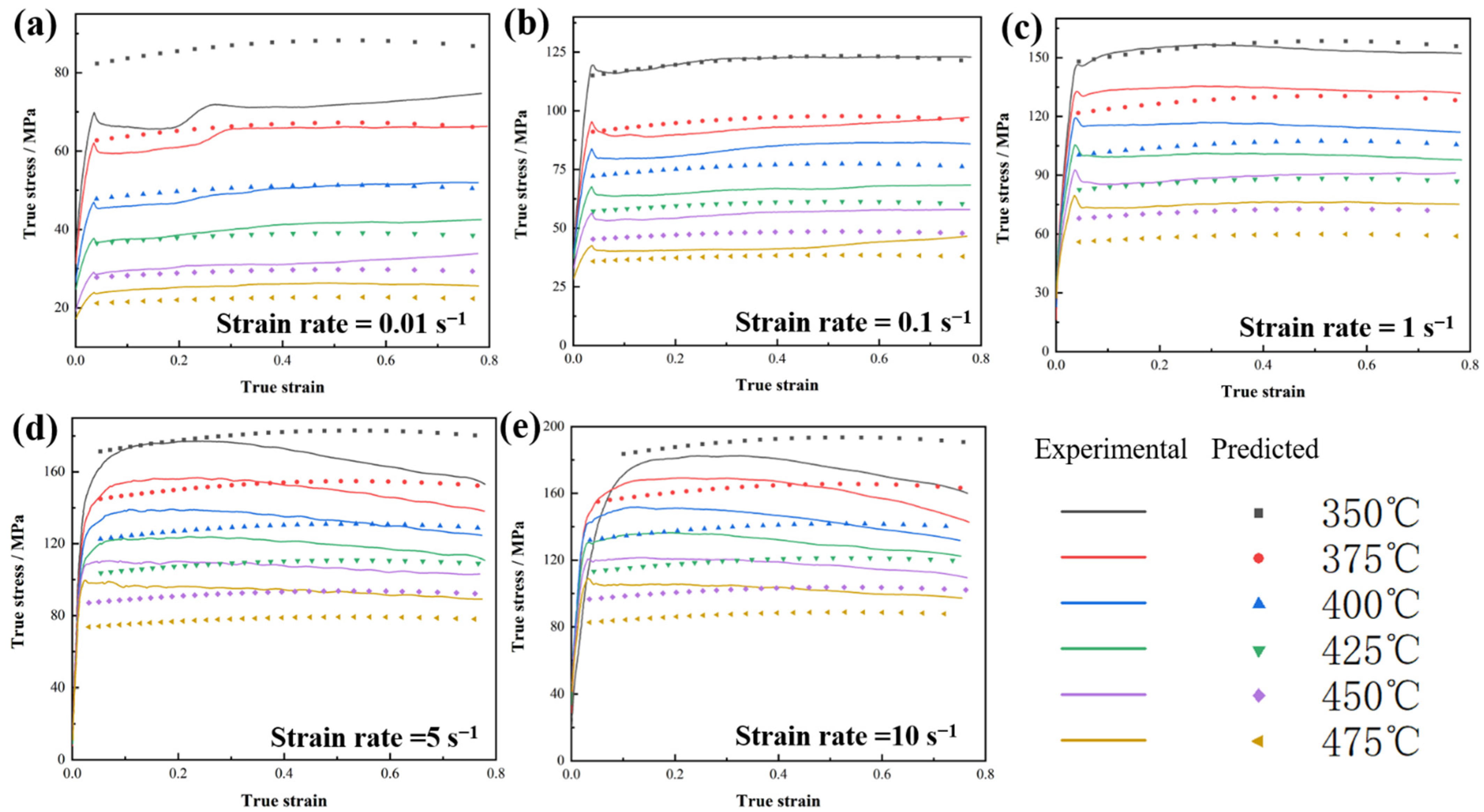
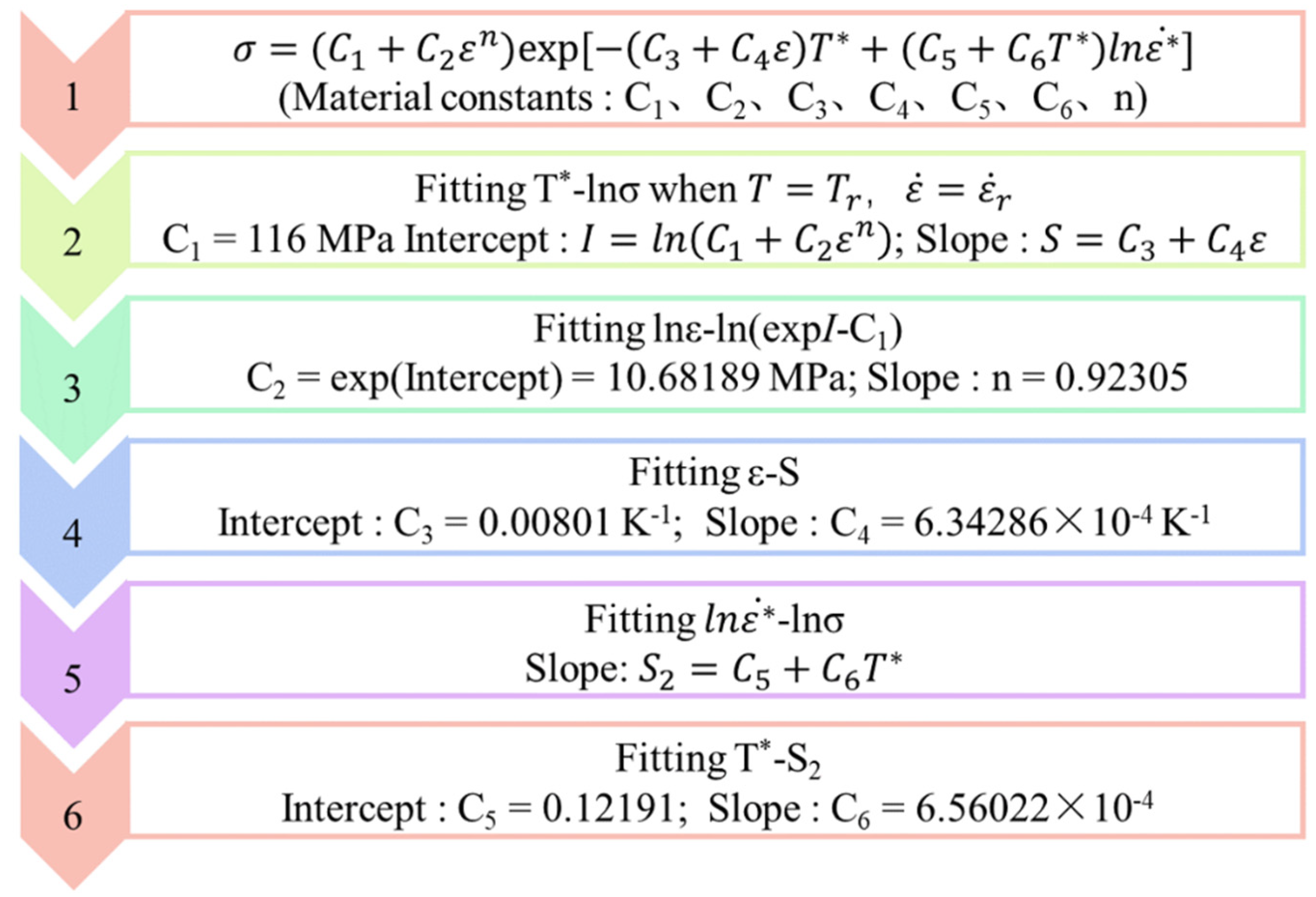


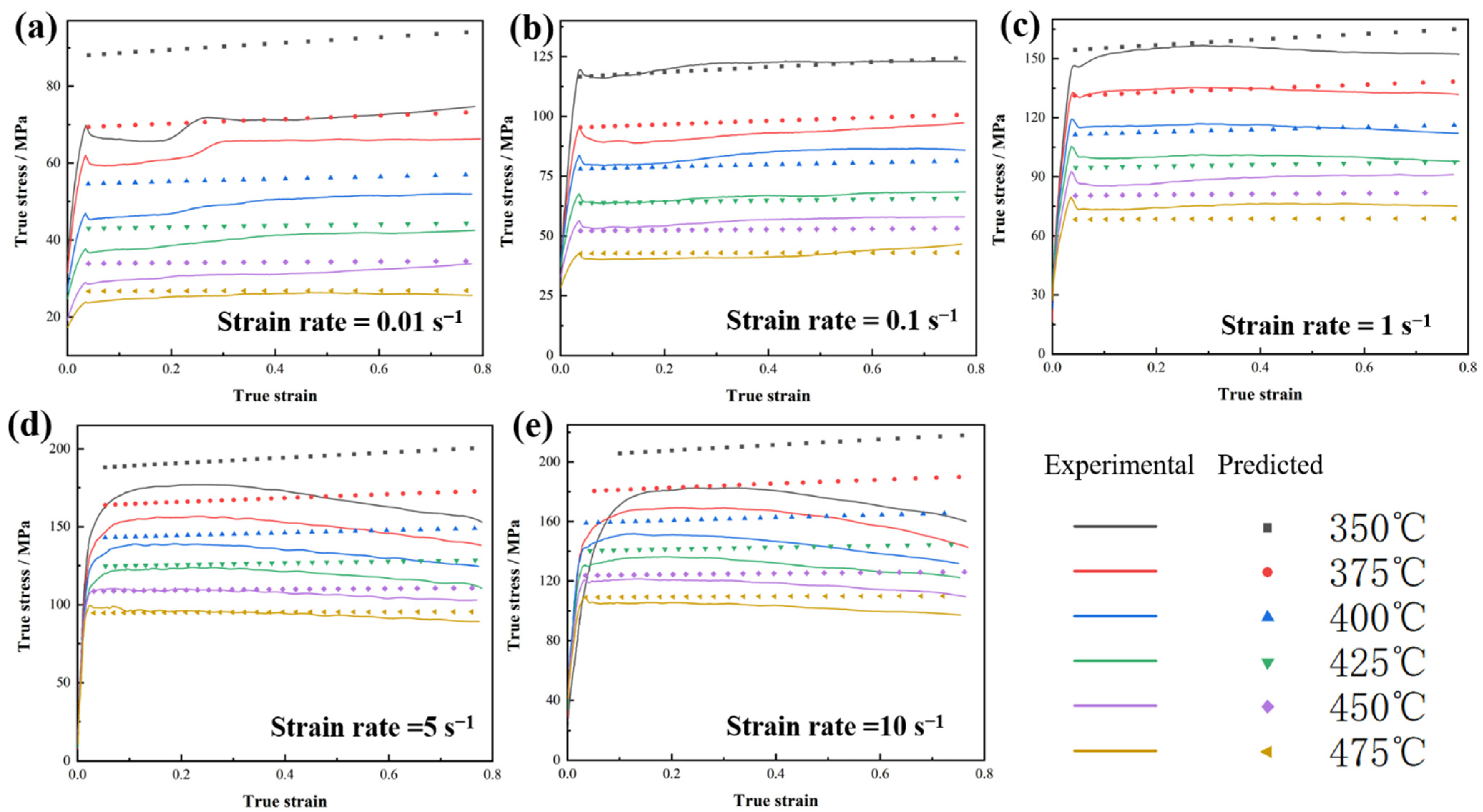
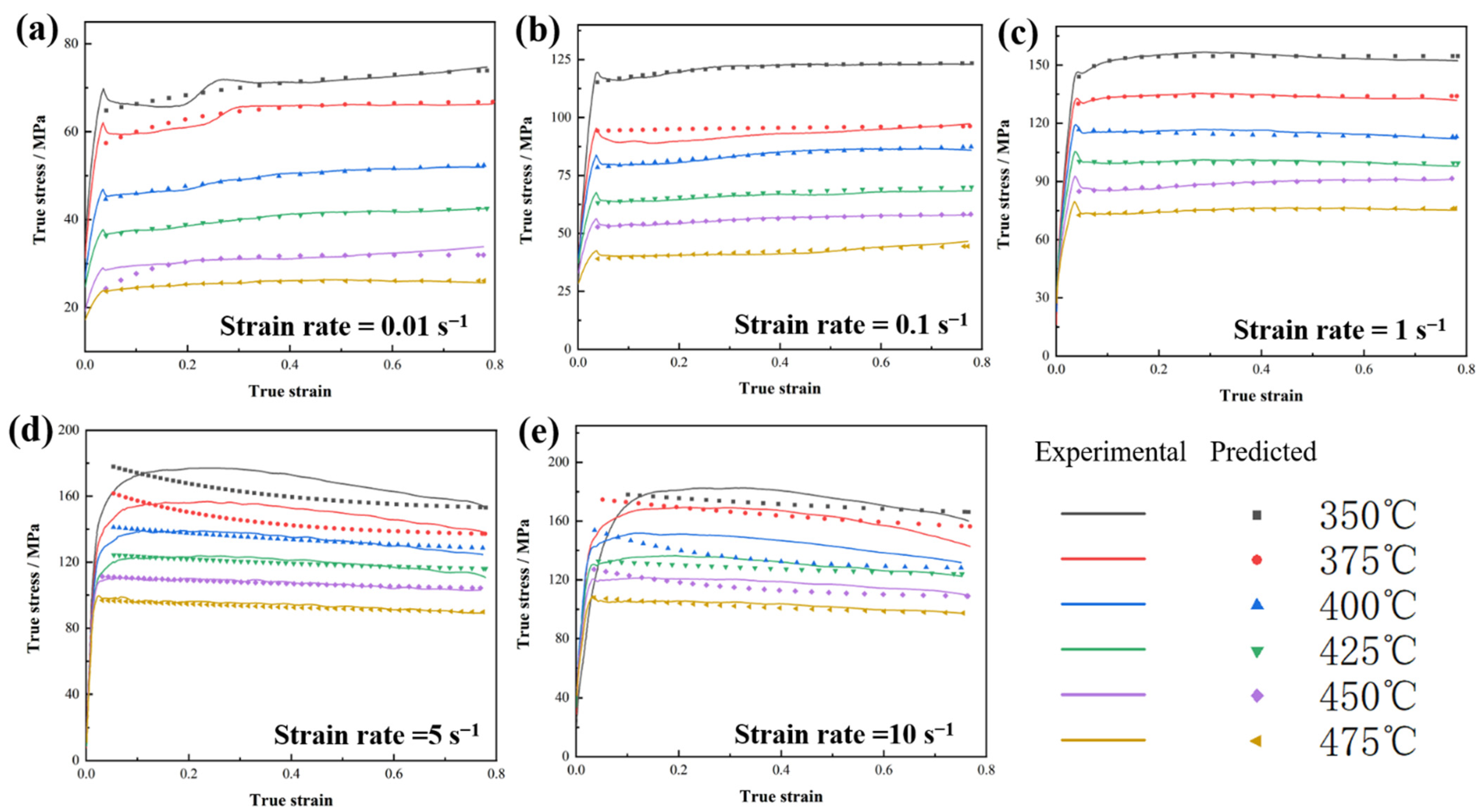
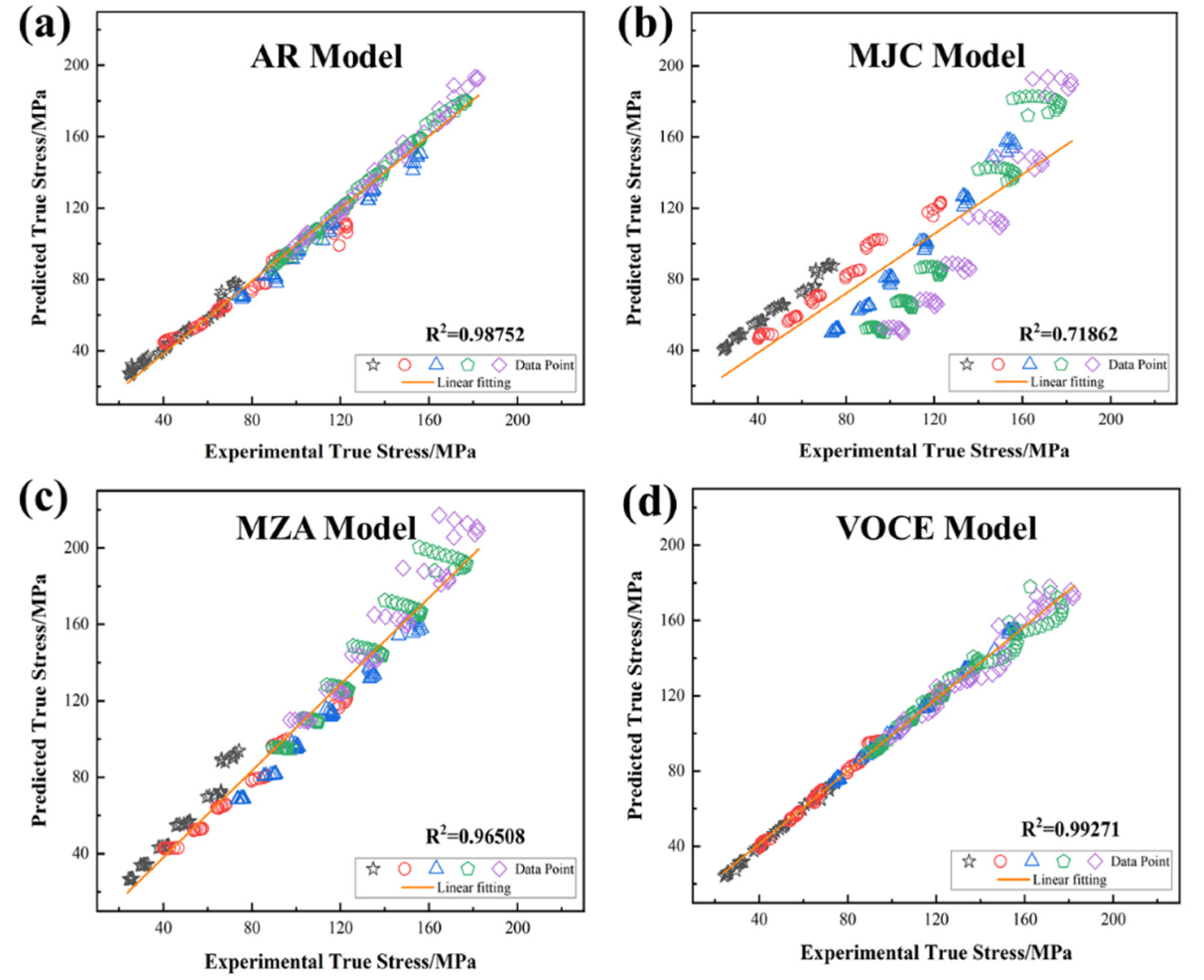



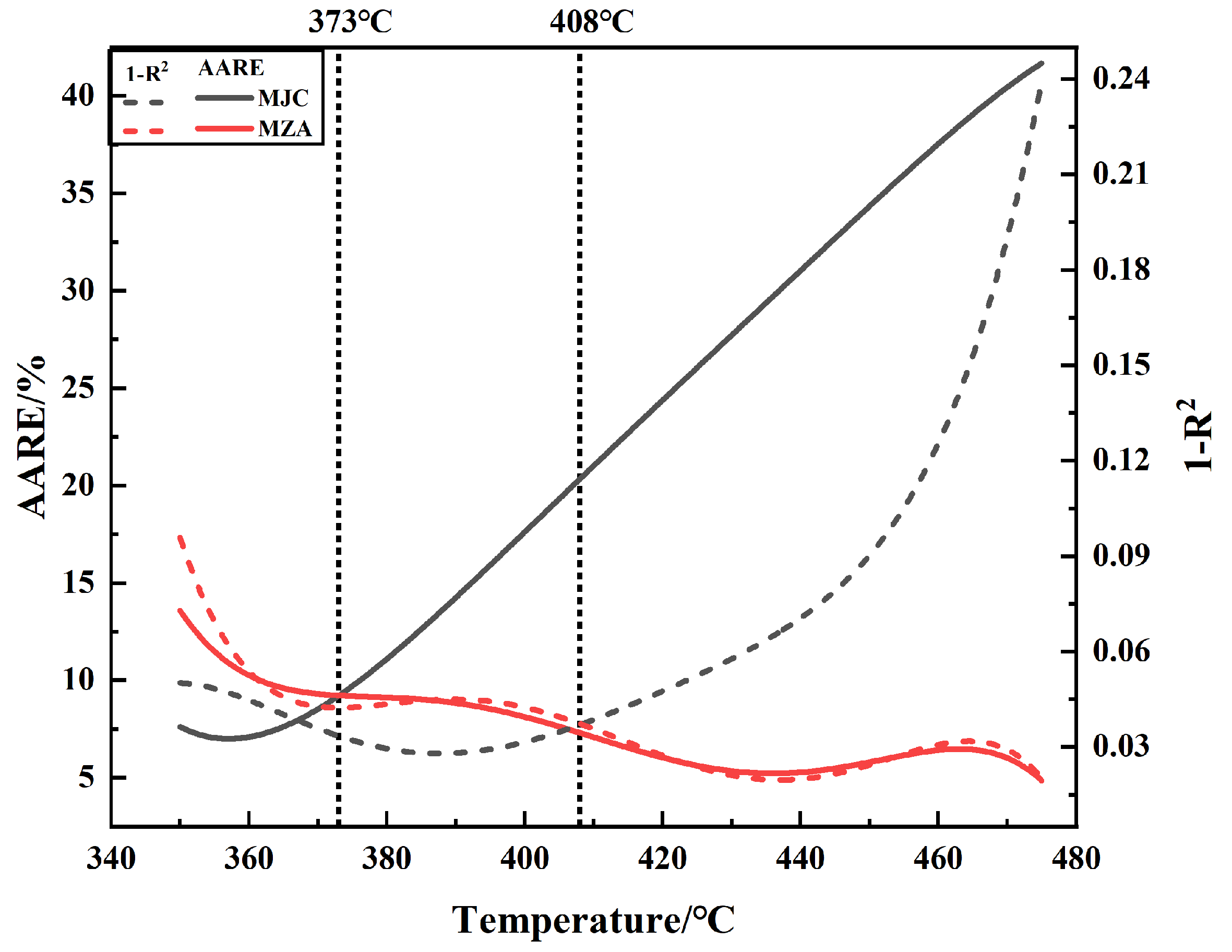
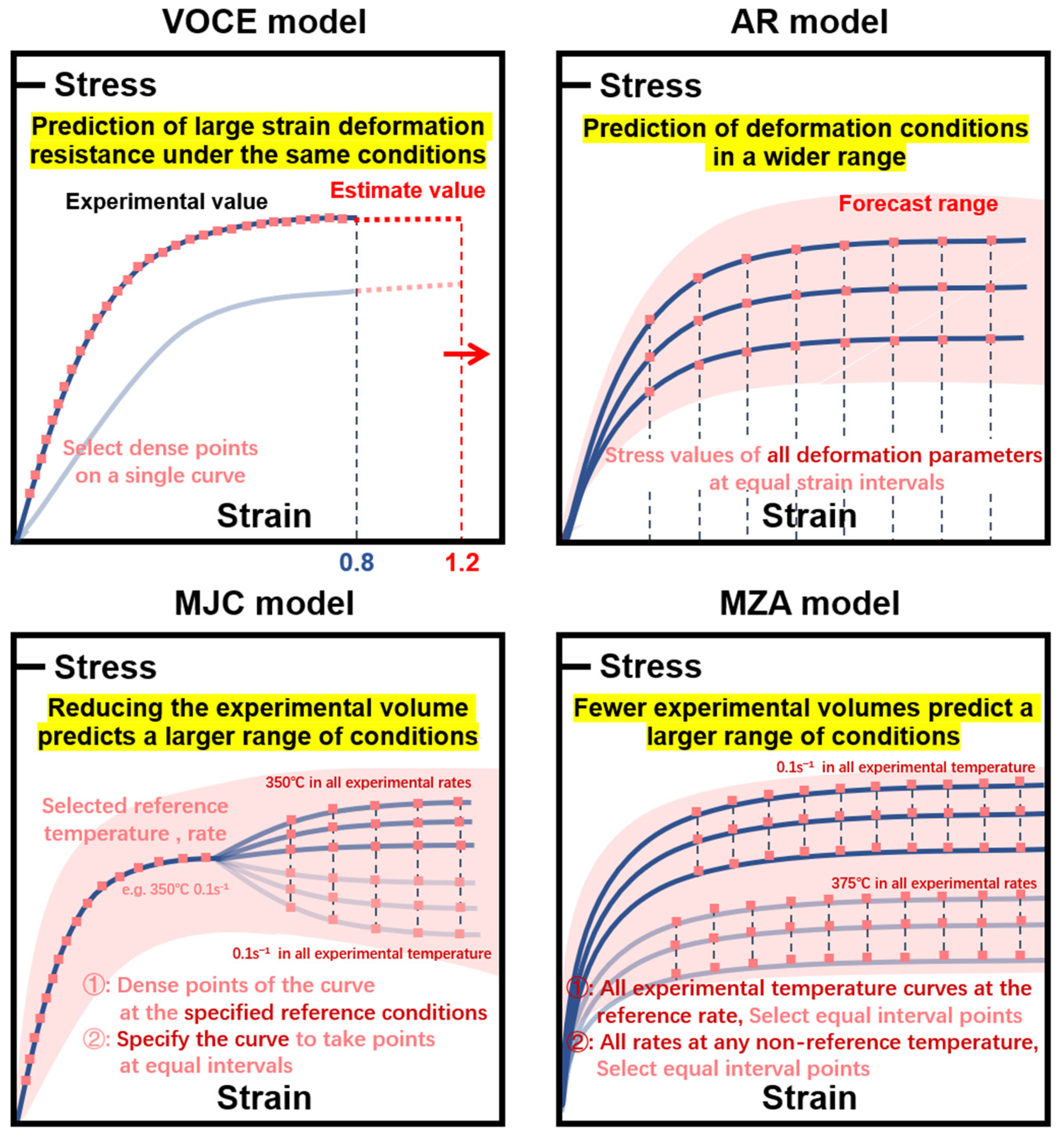

| Mg | Li | Si | Fe | Zn | Zr | Cr | Cu | Mn | Ni | Al |
|---|---|---|---|---|---|---|---|---|---|---|
| 4.272 | 2.000 | 0.976 | 0.545 | 0.295 | 0.252 | 0.187 | 0.140 | 0.134 | 0.90 | Bal. |
| Strain Rate/s−1 | Temperature/℃ | |||||
|---|---|---|---|---|---|---|
| 350 | 375 | 400 | 425 | 450 | 475 | |
| 0.01 | 71.9 | 65.9 | 51.9 | 42.4 | 33.8 | 26.3 |
| 0.1 | 122.4 | 97.3 | 86.5 | 68.3 | 57.9 | 46.5 |
| 1 | 156.7 | 135.4 | 119.2 | 105.4 | 92.5 | 79.5 |
| 5 | 177.0 | 156.7 | 139.1 | 123.8 | 110.3 | 95.5 |
| 10 | 182.5 | 169.2 | 151.7 | 136.4 | 121.4 | 108.8 |
| Strain | α | n | Q/(kJ/mol) | lnA | Strain | α | n | Q/(kJ/mol) | lnA |
|---|---|---|---|---|---|---|---|---|---|
| 0.050 | 0.012209 | 4.559042 | 137.9106 | 22.30845 | 0.400 | 0.011745 | 4.614320 | 158.0668 | 25.73670 |
| 0.075 | 0.012118 | 4.338828 | 139.7770 | 22.61232 | 0.425 | 0.011763 | 4.649310 | 158.6621 | 25.83112 |
| 0.100 | 0.012068 | 4.266068 | 142.5544 | 23.08178 | 0.450 | 0.011789 | 4.690368 | 159.2710 | 25.92943 |
| 0.125 | 0.012042 | 4.235275 | 143.7912 | 23.29156 | 0.475 | 0.011816 | 4.738713 | 160.5228 | 26.13667 |
| 0.150 | 0.012013 | 4.224244 | 144.3740 | 23.38943 | 0.500 | 0.011818 | 4.776697 | 160.4899 | 26.12919 |
| 0.175 | 0.012001 | 4.246913 | 145.9445 | 23.65418 | 0.525 | 0.011838 | 4.823432 | 161.2820 | 26.25799 |
| 0.200 | 0.011935 | 4.272918 | 146.6128 | 23.76984 | 0.550 | 0.011864 | 4.871419 | 162.1239 | 26.39138 |
| 0.225 | 0.011859 | 4.325442 | 149.2594 | 24.23295 | 0.575 | 0.011898 | 4.927463 | 163.2333 | 26.57052 |
| 0.250 | 0.011792 | 4.390176 | 152.3493 | 24.77550 | 0.600 | 0.011934 | 4.976719 | 164.6733 | 26.81127 |
| 0.275 | 0.011732 | 4.442624 | 154.1441 | 25.08933 | 0.625 | 0.011939 | 5.016171 | 164.7395 | 26.82268 |
| 0.300 | 0.011719 | 4.477367 | 155.5945 | 25.33984 | 0.650 | 0.011957 | 5.070479 | 165.5309 | 26.95745 |
| 0.325 | 0.011694 | 4.511795 | 156.2837 | 25.45718 | 0.675 | 0.011975 | 5.124941 | 166.5735 | 27.13054 |
| 0.350 | 0.011732 | 4.543699 | 156.9145 | 25.54825 | 0.700 | 0.011992 | 5.174292 | 167.8194 | 27.34495 |
| 0.375 | 0.011736 | 4.575884 | 157.4512 | 25.63442 | - | - | - | - | - |
| Strain | I | S | Strain | I | S |
|---|---|---|---|---|---|
| 0.10 | 4.74976 | 0.00808 | 0.45 | 4.80621 | 0.00818 |
| 0.15 | 4.75166 | 0.00808 | 0.50 | 4.80387 | 0.00807 |
| 0.20 | 4.76634 | 0.00816 | 0.55 | 4.80377 | 0.00795 |
| 0.25 | 4.77914 | 0.00818 | 0.60 | 4.80385 | 0.00783 |
| 0.30 | 4.79092 | 0.00821 | 0.65 | 4.80443 | 0.00779 |
| 0.35 | 4.79841 | 0.00822 | 0.70 | 4.80472 | 0.00773 |
| 0.40 | 4.80337 | 0.00819 |
Publisher’s Note: MDPI stays neutral with regard to jurisdictional claims in published maps and institutional affiliations. |
© 2022 by the authors. Licensee MDPI, Basel, Switzerland. This article is an open access article distributed under the terms and conditions of the Creative Commons Attribution (CC BY) license (https://creativecommons.org/licenses/by/4.0/).
Share and Cite
Yang, Y.; Dong, X.; Zhao, T.; Zhou, Z.; Qiu, Y.; Wang, F.; Luo, R. Application of Four Different Models for Predicting the High-Temperature Flow Behavior of 1420 Al–Li Alloy. Metals 2022, 12, 2029. https://doi.org/10.3390/met12122029
Yang Y, Dong X, Zhao T, Zhou Z, Qiu Y, Wang F, Luo R. Application of Four Different Models for Predicting the High-Temperature Flow Behavior of 1420 Al–Li Alloy. Metals. 2022; 12(12):2029. https://doi.org/10.3390/met12122029
Chicago/Turabian StyleYang, Yuyan, Xiaohui Dong, Teng Zhao, Zhou Zhou, Yu Qiu, Fei Wang, and Rui Luo. 2022. "Application of Four Different Models for Predicting the High-Temperature Flow Behavior of 1420 Al–Li Alloy" Metals 12, no. 12: 2029. https://doi.org/10.3390/met12122029
APA StyleYang, Y., Dong, X., Zhao, T., Zhou, Z., Qiu, Y., Wang, F., & Luo, R. (2022). Application of Four Different Models for Predicting the High-Temperature Flow Behavior of 1420 Al–Li Alloy. Metals, 12(12), 2029. https://doi.org/10.3390/met12122029






